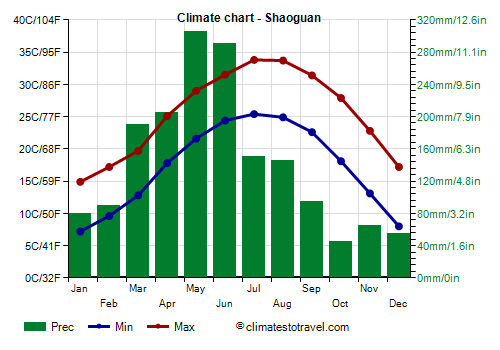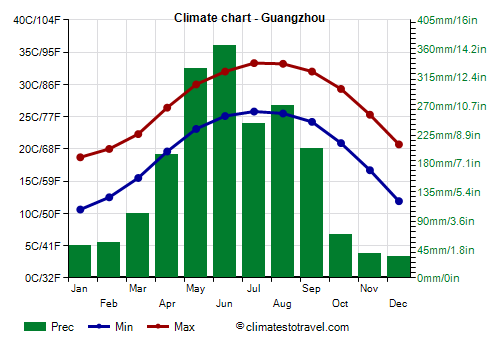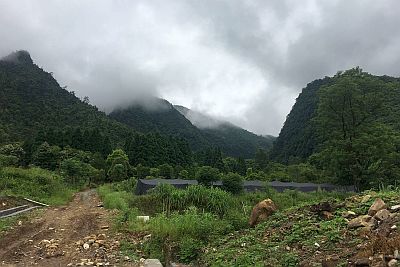Select units of measurement for the temperature and rainfall tables (metric or imperial).
Average weather, temperature, rainfall, sunshine hours
In Guangdong, a Chinese province overlooking the South China Sea coast, the climate is
subtropical, with mild winters and hot, muggy summers.
The rains are abundant, in fact they generally exceed 1,500 mm (60 in) per year. The rainiest period is from March to August in the north and from April to September in the centre-south.
The sun is rarely seen in spring, while it shines quite often in summer in the north and in autumn in the centre-south.
In the warm season, typhoons can pass.
Index
The north

In the
north, in cities like Lianzhou and Shaoguan, winter is not so mild, at least if we consider the latitude: the average January temperature is around 10/11 °C (50/52 °F). Sometimes it can even snow. In summer, especially in July and August, the combination of humidity and temperature makes the heat definitely unpleasant. Here are the average temperatures of Shaoguan.
Shaoguan - Average temperatures (1991-2020) |
| Month | Min | Max | Mean |
|---|
| January | 7.2 | 14.9 | 11 |
|---|
| February | 9.6 | 17.2 | 13.4 |
|---|
| March | 12.8 | 19.7 | 16.2 |
|---|
| April | 17.8 | 25.1 | 21.5 |
|---|
| May | 21.6 | 29 | 25.3 |
|---|
| June | 24.4 | 31.5 | 28 |
|---|
| July | 25.4 | 33.8 | 29.6 |
|---|
| August | 24.9 | 33.7 | 29.3 |
|---|
| September | 22.6 | 31.4 | 27 |
|---|
| October | 18.1 | 27.9 | 23 |
|---|
| November | 13.1 | 22.8 | 18 |
|---|
| December | 8 | 17.2 | 12.6 |
|---|
| Year | 17.2 | 25.4 | 21.25 |
|---|
In Shaoguan, 1,700 mm (67 in) of rain fall per year. The wettest period is from April to June; July and August are still quite rainy, while the least rainy season goes from autumn to the beginning of winter.
Shaoguan - Average precipitation| Month | Days |
|---|
| January | 80 | 11 |
|---|
| February | 90 | 12 |
|---|
| March | 190 | 19 |
|---|
| April | 205 | 17 |
|---|
| May | 305 | 18 |
|---|
| June | 290 | 19 |
|---|
| July | 150 | 14 |
|---|
| August | 145 | 14 |
|---|
| September | 95 | 10 |
|---|
| October | 45 | 6 |
|---|
| November | 65 | 8 |
|---|
| December | 55 | 8 |
|---|
| Year | 1715 | 155 |
|---|
The amount of sunshine in Shaoguan is not very good, and it is poor from January to June, while it becomes decent in July and August, but nothing more. In total, there are 2,400 hours of sunshine per year.
Shaoguan - Sunshine hours| Month | Average | Total |
|---|
| January | 3 | 85 |
|---|
| February | 3 | 80 |
|---|
| March | 2 | 65 |
|---|
| April | 3 | 90 |
|---|
| May | 4 | 125 |
|---|
| June | 5 | 145 |
|---|
| July | 7 | 215 |
|---|
| August | 6.5 | 200 |
|---|
| September | 5.5 | 170 |
|---|
| October | 5.5 | 170 |
|---|
| November | 4.5 | 140 |
|---|
| December | 4 | 125 |
|---|
| Year | 4.4 | 1610 |
|---|
The center-south
In the
center-south of Guangdong, the winter climate becomes very mild, while in the rest of the year, the temperatures are similar to those of the north, actually, they are slightly lower in summer because of the influence of the sea.

In the southern part, on the coast, we find the
Pearl River Delta, which is one of the most populated metropolitan areas in the planet, and includes, in addition to the two special administrative regions of
Hong Kong and
Macau, cities like
Dongguan,
Foshan,
Guangzhou (or Canton),
Shenzhen, Zhongshan, Huizhou, Jiangmen, Zhuhai, and Zhaoqing.
In Guangzhou, the average temperature ranges from 14.5 °C (58 °F) in January to 29.5 °C (85 °F) in July and August.
Guangzhou - Average temperatures (1991-2020) |
| Month | Min | Max | Mean |
|---|
| January | 10.6 | 18.7 | 14.6 |
|---|
| February | 12.5 | 20 | 16.2 |
|---|
| March | 15.5 | 22.3 | 18.9 |
|---|
| April | 19.6 | 26.4 | 23 |
|---|
| May | 23.1 | 30 | 26.6 |
|---|
| June | 25.1 | 32 | 28.6 |
|---|
| July | 25.8 | 33.3 | 29.6 |
|---|
| August | 25.5 | 33.2 | 29.4 |
|---|
| September | 24.2 | 32 | 28.1 |
|---|
| October | 20.9 | 29.3 | 25.1 |
|---|
| November | 16.7 | 25.3 | 21 |
|---|
| December | 11.9 | 20.7 | 16.3 |
|---|
| Year | 19.3 | 27 | 23.1 |
|---|
Precipitation amounts to 1.950 mm (76.5 inches). The trend is similar to that of Shaoguan and the north, although the wettest period begins later, in April, and continues until September.
Guangzhou - Average precipitation| Month | Days |
|---|
| January | 51 | 5 |
|---|
| February | 56 | 6 |
|---|
| March | 101 | 9 |
|---|
| April | 194 | 11 |
|---|
| May | 329 | 14 |
|---|
| June | 365 | 16 |
|---|
| July | 243 | 14 |
|---|
| August | 270 | 14 |
|---|
| September | 203 | 10 |
|---|
| October | 67 | 4 |
|---|
| November | 37 | 3 |
|---|
| December | 33 | 4 |
|---|
| Year | 1950 | 110 |
|---|
In the center-south too, the sun does not shine very often, and in particular, it is rarely seen from February to April.
Guangzhou - Sunshine hours| Month | Average | Total |
|---|
| January | 3.5 | 115 |
|---|
| February | 3 | 80 |
|---|
| March | 2 | 60 |
|---|
| April | 2.5 | 70 |
|---|
| May | 3.5 | 105 |
|---|
| June | 4 | 130 |
|---|
| July | 6 | 180 |
|---|
| August | 5.5 | 165 |
|---|
| September | 5.5 | 165 |
|---|
| October | 6 | 180 |
|---|
| November | 5.5 | 160 |
|---|
| December | 5 | 155 |
|---|
| Year | 4.3 | 1560 |
|---|
In the other cities of the Guangdong coast (
Zhanjiang, Yangjiang, Shanwei,
Shantou, and Chaozhou) and in the Chuanshan Archipelago, the climate is similar to that of the Pearl River Delta.
On the coast of Guangdong, the South China Sea is never cold (in fact, we are at the Tropic of Cancer), even though it becomes a little cool from December to March, when it drops to 20/21 °C (68/70 °F), while it is definitely warm in summer. Here are the average sea temperatures in Shantou.
Shantou - Sea temperature| Month |
|---|
| January | 20 |
|---|
| February | 20 |
|---|
| March | 21.5 |
|---|
| April | 23.5 |
|---|
| May | 25.5 |
|---|
| June | 27.5 |
|---|
| July | 28.5 |
|---|
| August | 28.5 |
|---|
| September | 28 |
|---|
| October | 26 |
|---|
| November | 23.5"> |
|---|
| December | 21 |
|---|
| Year | 24.5 |
|---|

In the inland areas of Guangdong, we find hills and
mountains. Among the peaks, in the south-west we find
Datian Ding, 1,704 meters (5,590 feet) high, while in the north, in the Nanling National Forest Park, we find
Shikengkong, the highest mountain in Guangdong, 1,902 meters (6,240 feet) high. It is a very humid area, covered by forests, and with streams that give life to waterfalls.
Typhoons
As mentioned, Guangdong can be hit by typhoons, the tropical cyclones of Southeast Asia. Typically, typhoons pass in this area from June to early November, but they have sometimes affected the area outside of this period, as happened in April 2008 and in May 2006. The area most at risk is the coastal one, since it can receive the strongest winds, as well as storm surges.
Best Time
It is not easy to find the
best period to visit Guangdong.
Winter can be a good time, at least in the south and along the coast, although in the second part of the season, the sky is often cloudy, in addition, it can be windy, and sometimes, especially in the north, it can get cold.
Spring is pleasantly warm, but also gloomy, and when the sun becomes a little more frequent, thunderstorms also begin, then by May, the air becomes sultry, and there is the risk (though still low) of typhoons.
In theory, autumn is the best season, but typhoons are still possible in October, while in November, there may be windy days, and at the end of the month, it can sometimes already be a bit cold.
All in all, the best periods are from mid-March to mid-April, and from mid-October to late November.
What to pack
In
winter: bring spring/autumn clothes, a sweatshirt or sweater, a jacket, a raincoat or umbrella, and a hat for colder days. In the north, add a jacket and a sweater. For the mountainous areas: bring warm clothes, a down jacket, a hat, gloves, and a scarf.
In
summer: bring tropics-friendly, lightweight clothing, a light sweatshirt for air-conditioned places, and a light raincoat or umbrella. For the mountains, add a sweatshirt and a light jacket.
Back to topSee also the
temperatures by month.